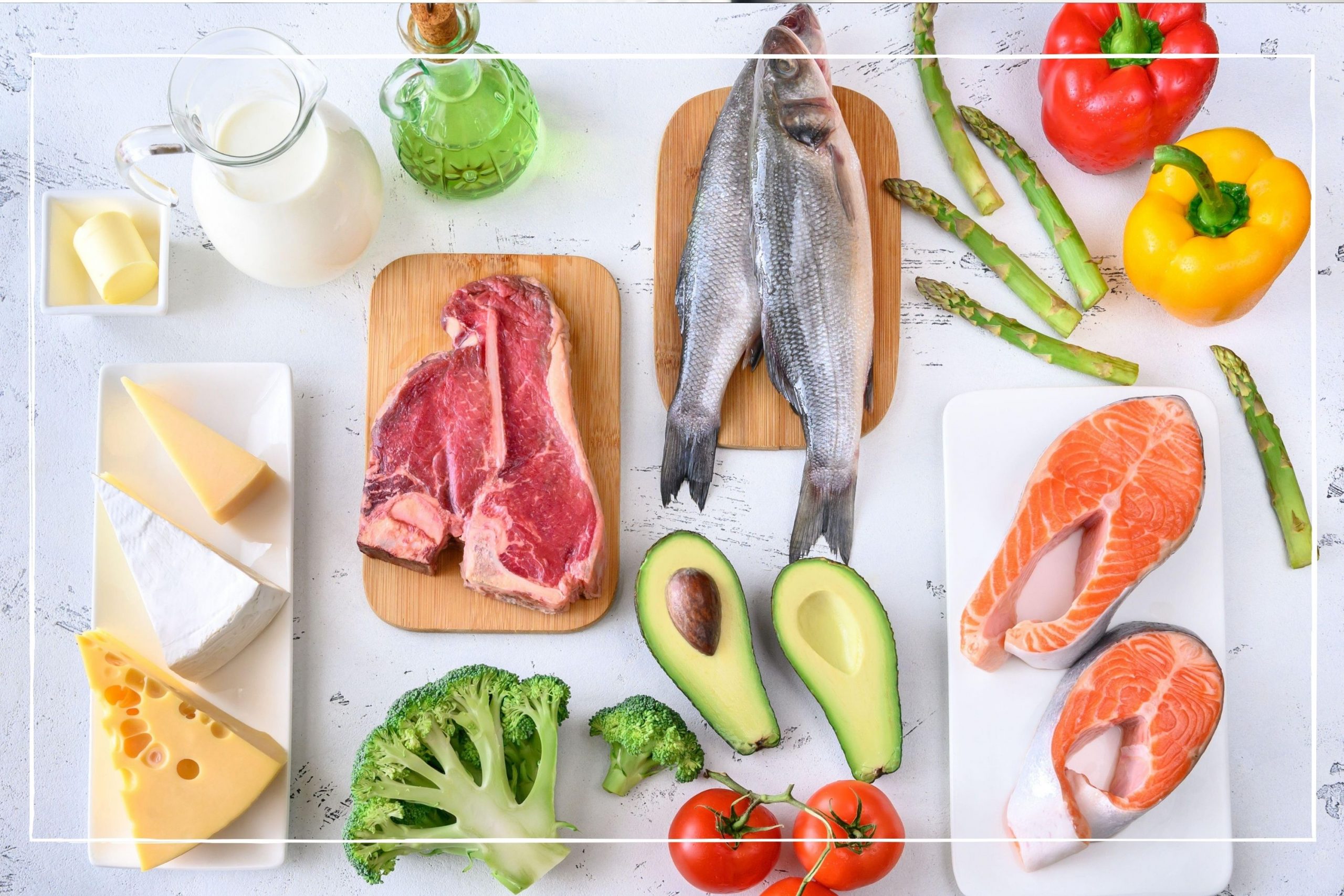Low-carb high-fat diet: how does the LCHF diet work and what can you eat?
A low-carb high-fat diet involves eating fewer carbohydrates and more healthy fats. It works by using ketones from the body’s fat stores for energy, rather than glucose from carbohydrates. So this is what makes it a popular eating plan for people who are trying to lose weight.


A low-carb high-fat diet may be just the healthy eating plan to help you lose weight.
A low-carb high-fat diet involves eating fewer carbohydrates and more healthy fats. It works by using ketones from the body’s fat stores for energy, rather than glucose from carbohydrates. So this is what makes it a popular eating plan for people who are trying to lose weight.
Registered nutritionist Emma Thornton explains: “The low-carb, high-fat diet switches your primary energy source from carbs and their simplest unit glucose to fats and their simplest unit called fatty acids."
Many people enjoy following a low-carb high-fat diet as, while it achieves weight loss results, it is easier to stick to than some diets. There are many different low-carb high-fat diets, some of the most popular are the Atkins diet and the Keto diet. Studies have also shown that a low-carb high-fat diet can be helpful for people with health conditions such as type 2 diabetes and heart disease.
However, people following a low-carb high-fat diet may experience some unpleasant side effects, while their body gets used to having fewer carbohydrates. These may include tiredness and muscle fatigue.
Researchers have also warned that there need to be more studies into the long-term implications of the diet and have warned that there could be complications like irregular heartbeats, kidney damage, and increased cancer risk. So if you are unsure whether a low-carb high-fat diet would suit you, speak to your GP or a registered nutritionist or dietitian.
How does the low-carb high-fat diet work?
The low-carb high-fat diet work by putting the body into a metabolic state known as ketosis. This means that instead of using glucose from carbohydrates for energy, it uses the body’s fat stores. This is why people following a low-carb high-fat diet often experience significant weight loss when they begin it.
Parenting advice, hot topics, best buys and family finance tips delivered straight to your inbox.
Our bodies need energy to keep working. Usually, we get this from carbohydrates. We can either get a quick hit of energy from simple carbohydrates, such as sugary snacks, which break down quickly in our bodies. Or alternatively, we can eat complex carbohydrates such as legumes, whole grains, and vegetables, which break down more slowly and release energy in a more stable way.
You can find carbohydrates in the following foods:
- Fruits
- Vegetables (especially starchy ones like potatoes and corn)
- Grains (bread, cereals, pasta, rice)
- Legumes (beans, lentils, peas)
- Milk
- Nuts and seeds
However, if we limit the number of carbohydrates we eat, our bodies must use another source to get the energy we need. This is where our fat stores come into play. When you eat a high-fat diet your body will begin to use the fat to fuel itself.
Registered nutritionist Emma Thornton says: “When you eat more fat than carbs the levels of your storage form of glucose, called glycogen, will fall. Glycogen is stored as a source of energy in our liver and also in and around our muscles. Instead, your body will utilise fat as a primary energy source. Fats are also stored in the liver and around the body in the form of triglycerides.”
Research published by Nutrition and Metabolism in August 2020 concluded, "Weight loss resulting from consumption of a diet lower in CHO (carbohydrates) and higher in fat may be beneficial for older adults with obesity
How does LCHF compare to Keto and Atkins?
The low-carb high-fat diet encourages a reduction of carbs and an increase in fats in your daily diet. While there are a number of different low-carb high-fat diet eating plans, such as Atkins and Keto, you can also adhere to the main principles without following a strict diet plan. Some people prefer this as it allows them to tailor the diet to their own bodies. For example, some people will be able to eat 100g of carbs a day and still lose weight, while others will need to reduce that amount to as low as 20g.
Our diets are made up of three macronutrients: carbohydrates, fat, and protein. The low-carb high-fat diet is an umbrella term for eating plans that reduce carbs and increase fats. While there are no strict percentages for a low-carb diet, this study defined low-carbohydrate as less than 26 percent of the daily macronutrient intake (or less than 130 gm/day) and very low-carbohydrate as less than 10% (or 20-50 gm/day).
In contrast, diets like Keto and Atkins have stricter limits on what you can and can’t eat. Which diet plan you decide to follow depends on your personality. Some people like the freedom to make their own decisions about what to eat, while others find it easier to stick to a more formal plan.
Here are the differences between the plans to help you decide which will work best for you:
Low-carb high-fat diet
- More flexible than Keto and Atkins
- Reduce your carbs to a daily amount that suits you and increase fats in your diet
- Work out the carbs in your food by either using the nutritional information label on the packet or an app
- Avoid processed food
You can count the carbs in your food using the nutrition information label or reference books and apps. People usually count carbs in grams or as carbohydrate portions (CP).
Remember that the amount you are going to eat will probably be different from the serving size on the label, or in the app, so you need to do some maths. Here’s how:
- By ‘total carbs per serving’ - If the serving size on the label is 75g and you will eat 150g, multiply the total carb value by two. This will give you the total carbs in your serving.
- By weighing out portions and using the 'per 100g' information - If there is 38g of carbohydrate per 100g and you weigh out your portion and it is 75g, multiply 38 by 0.75 to find the carbs in your serving (28.5g).
Keto diet
The Keto diet dates back to the 1920s when it was used as a treatment option for children with epilepsy. It is a low-carb, moderate-protein, and very high-fat eating plan. The aim of the diet is to put the body into a state of ketosis so that it prioritises burning fat for fuel.
- Very low-carb, moderate-protein, and high-fat diet
- Typically contains around 70% fat, 20% protein, and 10% carbs
- Carbs are more strictly counted and recommended to be between 20g to 50g a day
Atkins diet
The Atkins diet has been around since the 1970s. Rather than constantly being on a low-carb high-fat diet, followers gradually build up the amount of carbs they eat in order to maintain their target weight. It includes four steps: induction, second stage, pre-maintenance stage, and maintenance.
- Induction
- This is the hardest stage as you eat less than 20g of carbs per day for a minimum of two weeks
- You must remove alcohol, bread, dairy (except cheese and butter), fruit, grains, starchy vegetables, and sugar from your diet
- You may lose up to a stone in this stage
- Second stage
- This stage begins to add in more carbs, you can increase your intake to 25g to 45g a day
- You can start to add restricted amounts of berries, cream, leafy greens, legumes, melon, nuts, and yogurt to your diet
- You should remain at this stage until you’re around 10lb from your goal weight
- Pre-maintenance stage
- As you get closer to your goal weight, this stage allows you to add in more carbs up to 100g a day
- You can now add fruit, starchy vegetables, and whole grains into your diet
- You may see some weight gain during this stage, as your body begins to build up glycogen stores. However, you should just continue to eat healthily
- Maintenance
- The final stage of the Atkins diet sees you going back to eating healthy carbs in an amount your body can tolerate without gaining weight, for most people, this is around 100g a day
What can you eat on a low carb high-fat diet?
Low-carb high-fat diets are low in carbohydrates, high in fats and moderate in protein. When you are planning your diet you should be including lots of high-fat products, a modest amount of protein, and a small amount of carbs.
Make sure your meal plans include high-fat options such as meat, dairy and healthy fats like avocados and nuts. Then add a moderate amount of protein, such as fish, eggs, lentils and quinoa. Finally choose your carbs, depending on the amount you have decided to incorporate into your diet.
Registered nutritionist Emma Thornton says: “A low-carb, high-fat diet mainly consists of low carbohydrate, high fat and moderate protein options. This includes foods such as meat, oils for cooking, fish, eggs, avocados, lower carb vegetable options and nuts. Starchy foods like bread, pasta, potatoes, rice and other whole food options such as beans or lentils are often restricted as a result of their carbohydrate content.”
Low-carb high-fat foods:
- Meat: Beef, lamb, pork, chicken, turkey, duck
- Fish: Salmon, sardines, trout, cod, haddock
- Shellfish: Prawns, shrimp, crab, lobster, muscles
- Full-fat dairy: Cheese, butter, yoghurt, cream
- Eggs
- Non-starchy vegetables: Asparagus, beans, broccoli, cauliflower, kale, leeks, mushrooms, peppers, sprouts, lettuce, tomatoes, cucumber
- Avocados
- Berries (in moderation): Blueberries, blackberries, raspberries, strawberries
- Nuts: Cashews, almonds, hazelnuts, Brazil nuts, walnuts, pistachios
- Seeds: Pumpkin, chia, sunflower, poppy, sesame
- Oils: Olive oil, coconut oil, avocado oil
Carbohydrates:
- Fruits
- Vegetables (especially starchy ones like potatoes and corn)
- Grains (bread, cereals, pasta, rice)
- Legumes (beans, lentils, peas)
- Milk
- Nuts and seeds
Benefits of the low-carb high-fat diet
Many health experts recognise a low-carb high-fat diet as a successful way to lose weight. However, the benefits of a low-carb high-fat diet can also extend to a positive effect on conditions such as diabetes and high cholesterol.
Registered nutritionist Emma Thornton says: “Most low-carb, high-fat diets centre around mostly unprocessed whole foods. This means refined carbs which are thought to be particularly problematic for blood sugar levels and metabolic diseases are very low. A low-carb, high-fat diet, can also be helpful for weight loss if this style of diet is sustained. As glycogen, the storage form of glucose is bound to water in the muscles, this can help to minimise bloating and contribute to a ‘leaner’ physique.”
1. Weight loss
One of the main reasons why someone might follow a low-carb high-fat diet is to lose weight.
This study found that weight loss from a diet lower in cholesterol and higher in fat may be beneficial for older adults with obesity. The researchers believed this could be because it depletes adipose tissue depots, which are linked to poor metabolic symptoms and improves insulin sensitivity.
2. Stabilises blood sugar and insulin levels
Another benefit of a low-carb high-fat diet is that it can help to keep blood sugar levels stable. This is because it is mainly carbohydrates that affect them. This is why many people living with type 2 diabetes choose to follow this eating plan.
Lowering your carb intake can help improve blood glucose levels and insulin resistance.
This study found that following a low-carb diet for six months was associated with higher rates of remission among people with type 2 diabetes.
3. Reduces blood pressure
This meta-analysis looked at 13 trials following overweight and obese participants on either low-fat diets or very-low-carbohydrate ketogenic diets (of no more than 50g of carbohydrates a day). It found that the ketogenic diet produced a greater reduction in weight, triglycerides (fat found in your blood) and blood pressure, compared with the low-fat diet at one year.
4. Increases HDL ‘good’ cholesterol
Low-carb diets tend to be high in fat, which can have a positive impact on cholesterol levels.
In this study, however, they did also warn that this trial saw increased LDL or 'bad' cholesterol levels.
5. Reduces metabolic syndrome
With its positive effect on blood pressure, cholesterol and weight loss, it is no surprise that the low-carb high-fat diet can reduce the risk of metabolic syndrome. This is a collection of symptoms that include high blood pressure, abdominal obesity, and low HDL ‘good’ cholesterol levels.
In this BMC Nutrition trial, researchers asked 94 healthy obese adults to follow either a low-carb or low-fat diet for six months. They found that the participants in the low-carb group had a greater decrease in the prevalence of metabolic syndrome. At the beginning of the study, the prevalence of metabolic syndrome was 44.4% in the low-carb group. However, after 3 months this decreased significantly to 16.7 percent and to 3.7 percent after 6 months. So the researchers concluded that a low-carb diet had a greater effect in reducing the prevalence of metabolic syndrome.
Drawbacks of the low-carb high-fat diet
While it undoubtedly has its benefits, it is also worth being aware of the drawbacks of the low-carb high-fat diet. These are especially common to start off with, as your body gets used to having fewer carbs.
Researchers have warned that it may cause nausea, fatigue, and water and electrolyte losses, as well as limit your ability to exercise.
Registered nutritionist Emma Thornton says: "While some of the component parts of the diet are considered healthy, there are some drawbacks such as the lack of fibre this diet can risk offering. Fibre is extremely beneficial for digestive and cardiovascular health and helps to reduce the inflammatory burden of dietary components such as meat.
"Glucose is also actually a very efficient energy source for both the brain and our skeletal muscles. Whilst our bodies can adapt to using fats as a source of energy, glucose (which is still readily available from good-quality, unrefined complex carbs) would be the preferred option and the primary energy source."
A lack of fibre can also cause constipation. To avoid constipation it is important to add lots of non-starchy vegetables to your meals, such as kale, spinach, broccoli, Brussel sprouts, and asparagus.
Other side-effects may include:
- Diarrhoea
- Headaches
- Muscle cramps
- Dizziness
- Insomnia
As your body adapts to your diet change these symptoms should gradually decrease. However, if they don't you should consider increasing your carbohydrate intake.
What happens if you eat more fat than carbs?
When you eat more fat than carbs your body goes into a metabolic state known as ketosis. This means that instead of using glucose from carbohydrates for energy, it uses the body’s fat stores. This is why the low-carb high-fat diet is popular, as it is a proven way of losing weight.
Registered nutritionist Emma Thornton says: “Burning fatty acids as opposed to glucose switches your body into a state of ketosis. This is thought to offer some health benefits, both aesthetically and metabolically.”
Is a low-carb diet healthy? A nutritionist's verdict
Registered nutritionist Emma Thornton says: "While most low-carb high-fat diets discourage the consumption of processed items, plus refined carbs which can be detrimental to health, the potential to over-consume certain low-quality fats such as omega-6, plus the lack of fibre, in many cases, concerns me.
"Phytonutrients from plant-based foods, particularly when we consume a wide array of these nutrients, are thought to be extremely beneficial for health too and these would also be lacking in this style of diet. My advice would be to take some aspects of the low-carb, high fat style diet, such as the low consumption of processed foods and refined carbs, but not to restrict fibre-rich, complex carbs."
Video of the Week

Emily-Ann Elliott is an experienced online and print journalist, with a focus on health, travel, and parenting. After beginning her career as a health journalist at The Basingstoke Gazette, she worked at a number of regional newspapers before moving to BBC News online. She later worked as a journalist for Comic Relief, covering stories about health and international development, as well as The Independent, The i, The Guardian, and The Telegraph. Following the birth of her son with neonatal meningitis, Emily-Ann has a particular interest in neonatal health and parental support. Emily-Ann has a degree in English literature from the University of Newcastle and has NCTJ and NCE qualifications in newspaper journalism.